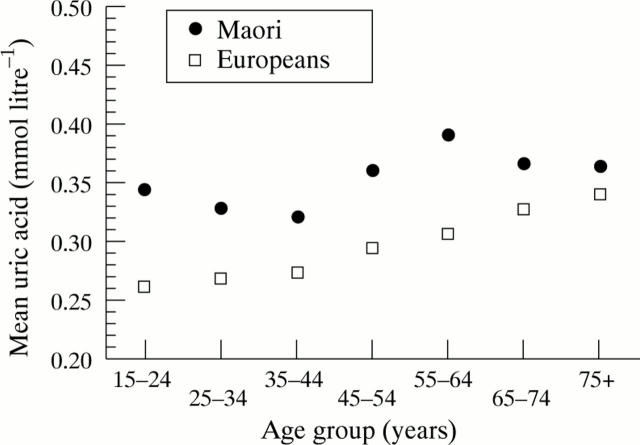Abstract
OBJECTIVE—To determine the current prevalence of hyperuricaemia and gout in New Zealand Maori and Europeans for comparison with previous studies. METHODS—342 Maori and 315 European men and women aged 15 years and older were studied by personal interview and a musculoskeletal system examination. The 1977 ARA criteria for gout in a survey setting were used and serum uric acid was determined by a uricase method. The data were compared with those of previous New Zealand studies. RESULTS—Gout was significantly more common in Maori (6.4%) than Europeans (2.9%) (Δ = 3.6%, 95% confidence interval 0.4 to 6.8) and in Maori men (13.9%) than in European men (5.8%) (Δ = 8.1%, 95% CI 1.0 to 15.2). Hyperuricaemia was significantly more common in Maori men (27.1%) than in European men (9.4%) (Δ = 17.7%, 95% CI 8.3 to 27.1) and in Maori women (26.6%) than in European women (10.5%) (Δ = 16.1%, 95% CI 8.5 to 23.7). At least 14% of hyperuricaemic individuals were receiving diuretics, of whom 78% were women. Comparison with previous studies shows that the prevalence of gout has increased in both Maori and Europeans, particularly in men. In Maori men the prevalence of gout has risen from 4.5-10.4% previously to 13.9%, and in European men from 0.7%-2.0% previously to 5.8%. Clinical differences included a stronger family history, earlier age at onset, and a higher frequency of tophi and polyarticular gout in Maori than Europeans. Of those with gout, 62% of Maori and 63% of Europeans were hyperuricaemic on the day surveyed and six (19.4%) were on diuretics. Treatment of gout was inadequate in most cases. CONCLUSIONS—Hyperuricaemia and gout remain common among Maori. Of concern is that the prevalence of gout appears to be on the increase, not only in Maori but also in Europeans in New Zealand.
Full Text
The Full Text of this article is available as a PDF (120.7 KB).
Mean serum uric acid concentrations in Maori and Europeans by age group.
Selected References
These references are in PubMed. This may not be the complete list of references from this article.
- BUCHANAN M. J., ISDALE I. C., ROSE B. S. SERUM URIC ACID ESTIMATION CHEMICAL AND ENZYMATIC METHODS COMPARED. Ann Rheum Dis. 1965 May;24:285–288. doi: 10.1136/ard.24.3.285. [DOI] [PMC free article] [PubMed] [Google Scholar]
- Badley E. M., Meyrick J. S., Wood P. H. Gout and serum uric acid levels in the Cotswolds. Rheumatol Rehabil. 1978 Aug;17(3):133–142. doi: 10.1093/rheumatology/17.3.133. [DOI] [PubMed] [Google Scholar]
- Beighton P., Solomon L., Soskolne C. L., Sweet M. B. Rheumatic disorders in the South African Negro. Part IV. Gout and hyperuricaemia. S Afr Med J. 1977 Jun 25;51(26):969–972. [PubMed] [Google Scholar]
- Brauer G. W., Prior I. A. A prospective study of gout in New Zealand Maoris. Ann Rheum Dis. 1978 Oct;37(5):466–472. doi: 10.1136/ard.37.5.466. [DOI] [PMC free article] [PubMed] [Google Scholar]
- Campion E. W., Glynn R. J., DeLabry L. O. Asymptomatic hyperuricemia. Risks and consequences in the Normative Aging Study. Am J Med. 1987 Mar;82(3):421–426. doi: 10.1016/0002-9343(87)90441-4. [DOI] [PubMed] [Google Scholar]
- Currie W. J. Prevalence and incidence of the diagnosis of gout in Great Britain. Ann Rheum Dis. 1979 Apr;38(2):101–106. doi: 10.1136/ard.38.2.101. [DOI] [PMC free article] [PubMed] [Google Scholar]
- FEICHTMEIR T. V., WRENN H. T. Direct determination of uric acid using uricase. Am J Clin Pathol. 1955 Jul;25(7):833–839. doi: 10.1093/ajcp/25.7_ts.0833. [DOI] [PubMed] [Google Scholar]
- Gibson T., Waterworth R., Hatfield P., Robinson G., Bremner K. Hyperuricaemia, gout and kidney function in New Zealand Maori men. Br J Rheumatol. 1984 Nov;23(4):276–282. doi: 10.1093/rheumatology/23.4.276. [DOI] [PubMed] [Google Scholar]
- Glynn R. J., Campion E. W., Silbert J. E. Trends in serum uric acid levels 1961--1980. Arthritis Rheum. 1983 Jan;26(1):87–93. doi: 10.1002/art.1780260115. [DOI] [PubMed] [Google Scholar]
- Hall A. P., Barry P. E., Dawber T. R., McNamara P. M. Epidemiology of gout and hyperuricemia. A long-term population study. Am J Med. 1967 Jan;42(1):27–37. doi: 10.1016/0002-9343(67)90004-6. [DOI] [PubMed] [Google Scholar]
- Isomäki H., v Essen R., Ruutsalo H. M. Gout, particularly diuretics-induced, is one the increase in Finland. Scand J Rheumatol. 1977;6(4):213–216. doi: 10.3109/03009747709095452. [DOI] [PubMed] [Google Scholar]
- LENNANE G. A., ROSE B. S., ISDALE I. C. Gout in the Maori. Ann Rheum Dis. 1960 Jun;19:120–125. doi: 10.1136/ard.19.2.120. [DOI] [PMC free article] [PubMed] [Google Scholar]
- Lawrence R. C., Hochberg M. C., Kelsey J. L., McDuffie F. C., Medsger T. A., Jr, Felts W. R., Shulman L. E. Estimates of the prevalence of selected arthritic and musculoskeletal diseases in the United States. J Rheumatol. 1989 Apr;16(4):427–441. [PubMed] [Google Scholar]
- MIKKELSEN W. M., DODGE H. J., VALKENBURG H. THE DISTRIBUTION OF SERUM URIC ACID VALUES IN A POPULATION UNSELECTED AS TO GOUT OR HYPERURICEMIA: TECUMSEH, MICHIGAN 1959-1960. Am J Med. 1965 Aug;39:242–251. doi: 10.1016/0002-9343(65)90048-3. [DOI] [PubMed] [Google Scholar]
- O'Sullivan J. B. Gout in a New England town. A prevalence study in Sudbury, Massachusetts. Ann Rheum Dis. 1972 May;31(3):166–169. doi: 10.1136/ard.31.3.166. [DOI] [PMC free article] [PubMed] [Google Scholar]
- PRIOR I. A., ROSE B. S., DAVIDSON F. METABOLIC MALADIES IN NEW ZEALAND MAORIS. Br Med J. 1964 Apr 25;1(5390):1065–1069. doi: 10.1136/bmj.1.5390.1065. [DOI] [PMC free article] [PubMed] [Google Scholar]
- Prior I. A., Rose B. S. Uric acid, gout and public health in the South Pacific. N Z Med J. 1966 May;65(405):295–300. [PubMed] [Google Scholar]
- ROSE B. S., PRIOR I. A. A SURGERY OF RHEUMATISM IN A RURAL NEW ZEALAND MAORI COMMUNITY. Ann Rheum Dis. 1963 Nov;22:410–415. doi: 10.1136/ard.22.6.410. [DOI] [PMC free article] [PubMed] [Google Scholar]
- Rigby A. S., Wood P. H. Serum uric acid levels and gout: what does this herald for the population? Clin Exp Rheumatol. 1994 Jul-Aug;12(4):395–400. [PubMed] [Google Scholar]
- Roubenoff R. Gout and hyperuricemia. Rheum Dis Clin North Am. 1990 Aug;16(3):539–550. [PubMed] [Google Scholar]
- Wallace S. L., Robinson H., Masi A. T., Decker J. L., McCarty D. J., Yü T. F. Preliminary criteria for the classification of the acute arthritis of primary gout. Arthritis Rheum. 1977 Apr;20(3):895–900. doi: 10.1002/art.1780200320. [DOI] [PubMed] [Google Scholar]



